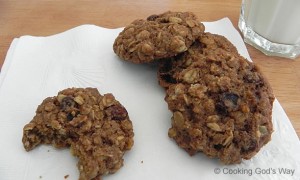 Finally, an oatmeal cookie that is “soaked” for optimum nutrition and really tastes like an oatmeal cookie! (If you want to learn more about why it is important to “soak” grains, it is covered in lesson 3 of our free eCourse.)
Finally, an oatmeal cookie that is “soaked” for optimum nutrition and really tastes like an oatmeal cookie! (If you want to learn more about why it is important to “soak” grains, it is covered in lesson 3 of our free eCourse.)
I have to say these cookies are soooo good you will find it hard to eat just one or two. They are loved by bother children and adults alike.
- 1 cup spelt flour
- 2 cups rolled oats (not instant)
- 3/4 cup butter or coconut oil, melted
- 2 Tablespoons raw apple cider vinegar
- 1 large egg
- 1/2 cup dark brown molasses sugar
OR dark muscovado sugar - 1/2 teaspoon unrefined sea salt (reduce to 1/4 tsp. if using salted butter)
- 1 1/2 teaspoons ground cinnamon
- 1/2 teaspoon baking soda
- 1/2 cup (packed) raisins, or more as desired
- 1/4 cup chopped walnuts, if desired (I omitted this time and they were still great)
8 to 12 hours before you want to bake the cookies: Add flour and oats to a large mixing bowl, mix gently to combine. Drizzle melted butter and vinegar over top of oat-flour mixture; stir in until moistened throughout. (Note: mixture will be moistened, though not “wet”, and somewhat crumbly.) Cover bowl and set aside, at room temperature, for 8+ hours (up to 12).
Cookie baking day (8+ hours later): Preheat oven to 375F. Line a large baking sheet with parchment paper, set aside.
In a medium bowl, whisk together the egg, brown sugar, salt, cinnamon, and baking soda.
Add egg-sugar mixture to the bowl of “soaked” flour-oats. Stir in with a wooden spoon until thoroughly combined.
Fold in raisins and nuts (if using).
Scoop cookie dough onto prepared baking sheet in 1 Tbsp. sized mounds, place in oven. After 5 minutes of baking, flatten the cookies slightly using the back of a small spoon. Bake for about 5 minutes more, until edges are golden and the cookies firm up in the middle.
Immediately remove cookies to a wire rack to cool.
Enjoy cookies slightly warm, or completely cooled, with a glass of cold milk…Yummm!
Makes about 40-cookies.




Hi,
My husband can’t tolerate spelt, but he can wheat… Can suggestions for substitutions for the spelt?
Also, do you think I could do a flax seed substitution(1 tablespoon ground flax and 3 tablespoons of water) for the egg?
I’m excited to try soaking the grains.. I never have for cookies before.
Thanks
Deborah, thanks for stopping by. Do you mean he doesn’t like spelt and instead likes wheat? I was just asking since I haven’t heard of anyone being intolerant, unable to digest, spelt but able to handle wheat. Since spelt is in fact wheat… just an older, non-hybrid, form of wheat. Anyhow, whether it is the former or the latter, You could try using wheat in this recipe if you like. I haven’t tried it so I really couldn’t help you there. I know spelt and regular wheat flour do act slightly differently, so you may need to adjust the amount of flour used.
I have never tried the flax-egg substitute in this recipe, but I think you could give it a shot.
Glad to be of help. Hope the cookies are a hit…have fun making them 🙂
Hello, I have sprouted buckwheat flour and gluten-free oats at home. When mixing the flour with oats do I still have to add the vinegar? Or is it enough just to mix them and let them sit for a few hours? Can the vinegar be felt a lot in the cookies? My boyfriend hates vinegar. Thank you! Renata
Renata, with sprouted flours it is NOT completely necessary to “soak” them in an acidic medium (vinegar, buttermilk, yogurt, etc.). Though with this recipe, the oats MUST be soaked along with the flour to neutralize the phytic acid in them. Just an FYI – this recipe was tested with spelt flour, not buckwheat. Since buckwheat flour and spelt flour act very differently, I cannot say if it will work as I haven’t tested it. 🙂
As far as tasting the vinegar in the cookies, the recipe uses so little it is not a problem. I have never had anyone complain it. Everyone enjoys them!
I love oatmeal raisin cookies but I did not know I was missing out. These cookies are amazing and will be the only way I make oatmeal raisin cookies for my family. Thanks for such a great recipe.
These are awesome! A tad time consuming, but so worth the effort! Have you tried doubling the recipe and then freezing it so that the next time you make cookies, all the work is done (minus the baking, of course)? I’m such a Dan of molasses, I cut the sugar back a bit and added more molasses – just not so much as to make it gooey, but I really think the dark brown molasses sugar is what makes it!
Love this recipe, so easy and so tasty!
If I had these available every day, children would certainly not be a bother while loving the cookies lol!
Can I use organic coconut sugar instead of dark molasses sugar? I do have some molasses so I could also add a little of that to give it the molasses taste…maybe?
Jen, thanks for writing. My only concern is that the molasses would add too much moisture to the cookies because of its liquid state. If you do give it a try, I would suggest only using 1/2 to 1 teaspoon of molasses. The flavor will probably be different…not necessarily bad, but different than if you used the dark brown sugar the recipe calls for.
Could you use steel cut oats for this? Thanks for all your recipes!
Julie, thanks for the nice comment. This recipe was designed for regular rolled oats. I do not think it would turn out satisfactorily with steel cut oats since they are more coarse and chewy.
Have you thought about adding the walnuts at the beginning so that they can also soak? I prefer them this way, and the same principle applies to the walnuts as well as the grains regarding the phytic acid.
Tamara, thanks for the comment. That is a good thing to bring up. I just usually soak, then dry all my nuts beforehand so I can add them to whatever and not worry about it 🙂 Though if you haven’t already soaked the nuts, you could add them to the mixture in the beginning so they can “soak”.
I just made these and they are wonderful! I have been looking for a good soaked-cookie recipe because sprouted flour can get expensive… plus oatmeal cookies are one of my favorites!
By the way, I used plain old whole wheat flour because we were tragically out of spelt and it worked just fine. And it wound up soaking for almost 24 hours… because I’m disorganized. 😉
I linked this post to my “My Week on Wednesday…January 29” post.
Thanks for this! 🙂
~ Christine
Christine, thanks for the comment. Glad to hear you enjoyed the cookies 🙂 It’s also good to know that they turned out fine with whole wheat flour. Oatmeal cookies sure are yummy!
Hi. Have already put my mixture together to soak. From what I’ve read about phytic acid in oats, is 8-12 hours long enough soaking? Would it matter if I left it for 24hours?
8 to 12 hours should be sufficient to neutralize the phytic acid. Though if you desired you could soak for up to 24 hours… it wouldn’t hurt anything.
THANK YOU! I have been searching for a soaked, sprouted or sourdough cookie and this is IT! YUMMY! We omitted the cinnamon, nuts and raisins and added mini chocolate chips and it was so good too. We use palm sugar and it worked great, just in case anyone was wondering 🙂
Theresa, glad you liked them… chocolate chips sound good 🙂
is it sufficient enough to soak the oats and flour in butter and vinegar to break down phytic acid? i thought flour had to be soaked in water vinegar or yogurt?
thanks!
To break down the Phytic Acid all you need to do is create an acidic environment. Buttermilk, kefir, and yogurt are also “acidic” ingredients that can work with “soaking” to neutralize phytic acid… but those do not work in this recipe as it will give an “off” texture. So with this recipe, the vinegar (which is acidic) comes into play… it will neutralize the phytic acid and keep that “cookie” texture 🙂
This recipe looks yummy. I often buy sprouted oatmeal so I don’t have to soak it. Should I still soak the sprouted oats? Have you heard of To Your Health Sprouted Flour Co.? http://www.organicsproutedflour.net/ I buy my sprouted flour and oats from them. It’s great.
You do not need to soak the sprouted flour, as the sprouting process already neutralizes the phytic acid in the oats.
Yes I am familiar with sprouted flour and To Your Health Sprouted Flour Co. but have not purchased from them personally.
I says to soak the flour and oats. Is spelt a flour?
Yes spelt is a flour. It is basically a form of wheat that has not been hybrid and modified like other wheat has.
We are newly gluten-free… What do you think of replacing the spelt with an alternative flour (almond, coconut)?
Gluten-fee flours work differently, so I do not think that substituting would work in this recipe.
You might try searching for a specific gluten-free oatmeal cookie, like this one (though I’d really lower the sugar in it myself) OR this Flourless Oatmeal Cookie looks good. Though I can’t vouch for any of them since I have not tried either one.
LOVE your site–it’s helpful and I love the design. My question is can you substitute whey for the vinegar? Thanks!
Thank you! Yes you can use whey in the cookies instead of vinegar, just be sure that the butter the cooled before adding the whey in.